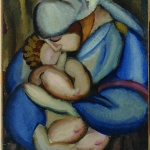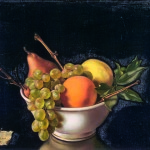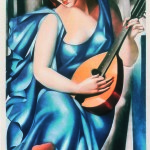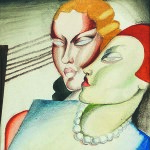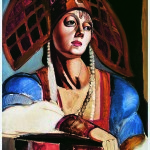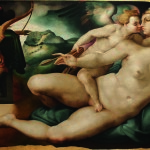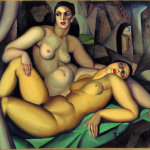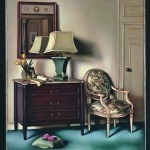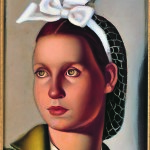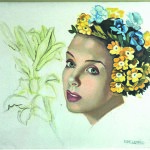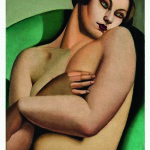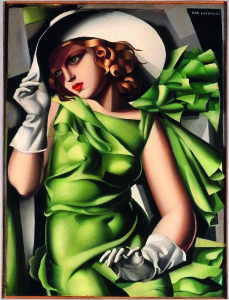
[dropcap]T[/dropcap]he Tamara de Lampicka exhibition hosts from 19 March to August 31, 2015 in the exhibit area of Palazzo Chiablese, part of the Polo Reale complex, over 80 works by the artist. The thematic itinerary features [highlight color=”yellow”]Lempicka’s most iconic and renowned works[/highlight], while also shedding light on specific aspects of her life and artistic career.
A wide-ranging, detailed, fascinating and evocative itinerary is what makes the new exhibition on Tamara de Lempicka – a symbol of elegance and transgression, independence and modernity.
The exhibition is curated by Gioia Mori, promoted by the Department of Cultural Affairs of the Turin City Council, the Ministry of Cultural Heritage and Activities and Turism and the Polo Reale of Turin, and produced by 24 ORE Cultura – Gruppo 24 Ore and the Arthemisia Group.
As the curator Gioia Mori writes,
“With its original perspective, the new exhibition highlights a range of different aspects. It presents Lempicka’s more intimate and secret life and shows how Tamara’s “worlds” can still reserve a few surprises. This is an exhibition to be explored as though travelling through parallel universes and which emphasizes the artist’s relation with leading photographers of her day, as well as her ongoing study of the art of the past, which enabled her to develop a unique style through the mingling of ancient and modern”.
The [highlight color=”yellow”]first work[/highlight] to greet visitors is Girl in a Green Dress, on special loan from the Pompidou Museum in Paris. The painting, which marked the artist’s official breakthrough, was purchased by the French state in 1932 and displayed in the Polish section of the recently refurbished Jeu de Paume.
[divider style=”dashed” top=”20″ bottom=”20″]
[divider style=”dashed” top=”20″ bottom=”20″]
The itinerary
The itinerary opens with the section Tamara de Lempicka’s World: a journey to explore the many houses in which the artists lived between 1916 and 1980 – the year of her wedding in St Petersburg and that of her death at Cuernavaca.
These places are set in relation to Lempicka’s artistic development: from the watercolours of her Russian period to the portraits she executed in her Parisian ateliers in the 1920s; from the works created in King Vidor’s large colonial mansion – designed by architect Wallace Neff – in Beverly Hills to the paintings from the 1940s, reflecting the furnishings and décor of her home in New York.
This gaze on Lempicka’s private rooms also encompasses her cultural frames of references. It brings out unexpected relations, such as that between the painting A Street at Night and the photographs by Kertész and Brassaï, which capture the same amazement felt by Eastern European refugees at the sight of the city “of lights” – their adopted home.
The [highlight color=”yellow”]second section[/highlight], Madame la Baroness, Modern Medievalist, takes its name from an article published in the United States in the early 1940s and describing Lempicka’s technical skill, as exemplified in particular by her still-lifes – the first genre which the artist explored in her teenage years and which she brought to a hight of excellence in the 1940s. The works on display include The Shell, an extraordinary trompe l’oeil from 1941, and some paintings of hands, a favourite subject of several photographers in the 1920s and 1930s, including Kertész, Kollar, and Dora Maar, whose pictures are here compared to Lempicka’s paintings.
The[highlight color=”yellow”] third section[/highlight], The Artist’s Daughter (the title of an article published in the US in 1929), presents the works which the artist devoted to her daughter Kizette, and which brought her the greatest acknowledgement. These include Kizette on the Balcony, awarded in 1927, and The Communicant, awarded in 1929 – on loan from the Pompidou and Roubaix museums.
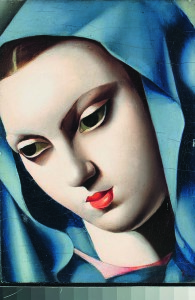
An ambivalent woman, Lempicka combined a transgressive lifestyle with an unexpected interest in “devotional” painting. The [highlight color=”yellow”]fourth section[/highlight], Sacred Visions, brings together paintings of Virgins and saints: from the 1931 Mother and Child from the Musée des Beaux-Arts in Beauvais, to the 1934 Blue Virgin from a private collection; from the Lybian Sybil – a copy of the sacred pagan figure from Michelangelo’s Sistine Chapel – to Lempicka’s own favourite painting, The Mother Superior from the Nantes museum.
The [highlight color=”yellow”]fifth section[/highlight], Dandy Déco, illustrates Lempicka’s ongoing relation with the fashion world, a relation she first established when working as an illustrator for some famous magazines in 1921. On display here are many of Lempicka’s most iconic works, such as Sharing Secrets (1928), The Blue Scarf (1930), and the remarkable Portrait of Ira Perrot (1931-1932). Gioa Mori has identified all the dresses worn by the models in these paintings as genuine creations by Lempicka’s favourite fashion designers, from Lucien Lelong and Marcel Rochas to the Maison Blanche Lebouvier. The extensive fashion section also features the photographs that were taken for the other career which Lempicka pursued in parallel to her work as an artist from the 1930s onwards: as a model, she was immortalized by the greatest fashion photographers of her day, from d’Ora to Joffé and Maywald. Lempicka’s “culture of appearance” – which makes her a genuine embodiment of female dandyism of the Deco age – is encapsulated in a space conceived as a 1930s “luxury shop window”, with a variety of hats by Descat, Schiaparelli and other designers, and jewellery by Cartier, Van Cleef & Arpels, and Mauboussin: the kind of “accessories” required by the standard of elegance of the period, all from important private collections.
In the [highlight color=”yellow”]sixth section[/highlight], Outrageous Tamara, explores the theme of the couple: from the heterosexual one at the centre of Hayez’ The Kiss – here on display in a watercolour version from the Veneranda Biblioteca Ambrosiana in Milan which is displayed alonside a copy executed by Lempicka – to Lesbian couples, which are presented alongside photographs of women-only bars by Brassaï and Harlingue. A work that stands out in this section is the 1923 Perspective from the Petit Palais in Geneva, the first painting to earn the attention and appreciation of critics at the time.
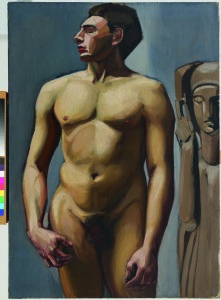
The [highlight color=”yellow”]seventh section[/highlight], Love Visions, illustrates the considerate attention the artist showed towards the men and women she loved through some outstanding nudes: the only Male Nude she ever painted and depictions of all the women who stirred her desire, including the masterpieces The Pink Tunic, The Beautiful Rafaela, Nude with Buildings, and Nude with Sails. On display for the first time is the main source of inspiration behind Lempicka’s nudes: Pontormo’s Venus and Cupid, in a 16th-century version by a Florentine Mannerist. From the works of the past Lempicka extended her research to the study of modern nude photography: the pictures taken by Laure Albin Guillot and Brassaï reveal the artist’s research on the poses and lighting used in photographic studios.
[divider style=”dashed” top=”20″ bottom=”20″]



